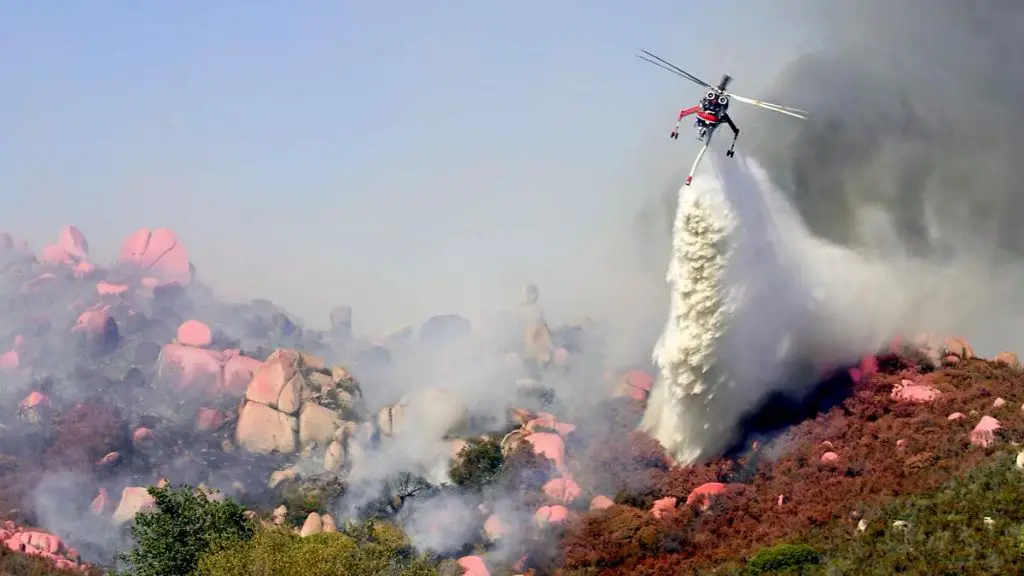What Was The Cause Of The Coyote Fire?
The Coyote fire was a wildfire that started on August 17, 2022 in the rural community of Potrero in southeastern San Diego County, California. The fire originated in the Coyote Canyon area off Coyote Holler Road and quickly spread, fueled by hot, dry, and windy conditions. Within the first few hours, the fire had grown to over 100 acres with a dangerous rate of spread. Over the next couple days, the fire continued spreading and exhibiting extreme fire behavior as it burned through rugged terrain and dense brush. By August 19, the Coyote fire had scorched over 1,500 acres and was threatening homes in Potrero. Firefighting efforts were hampered by the remote location and difficult access. Mandatory evacuation orders were issued for portions of Potrero, impacting hundreds of residents.
Timeline of Events
The Coyote Fire started on August 17, 2023 when a vehicle fire occurred on the 23000 block of Coyote Holler Road at around 12:11pm according to CalFire incident reports. The fire was initially reported as 5 acres with a critical rate of spread. Within a few hours, pushed by 20mph winds, the fire had grown to 50 acres.
By late afternoon on August 17th, the fire had exploded to 500 acres and was 0% contained with structures threatened in the vicinity. Evacuation orders were issued for communities near Coyote Canyon as firefighters rushed to try and protect homes.
Strong winds gusting 30-40mph caused extreme fire growth overnight into August 18th. The fire topped 5000 acres burned by the morning of August 18th. Containment remained minimal at 5% despite hundreds of firefighters battling the flames. More evacuation orders were issued.
Firefighting efforts managed to slow growth on August 19th as weather conditions improved slightly. However, the fire still grew to over 7500 acres with 15% containment. Mop-up operations began in areas already burned.
By the morning of August 20th, forward spread of the fire was stopped after burning 7619 acres. Containment grew to 45% as firefighters made progress digging fire lines and attacking hotspots. The last evacuation orders were lifted on August 21st as the fire reached 90% containment.
Origin and Cause
According to official reports, the Coyote fire started in the early morning hours of August 15, 2023 near the rural community of Potrero in southeastern San Diego County. The precise point of origin was off State Route 94 and Forrest Gate Road (source).
Investigators determined the fire began as a result of arson. Surveillance footage captured an individual intentionally setting fire to dry brush along the roadside shortly before 2am. The suspect has not yet been identified or apprehended (source).

The area where the fire started consists of hilly, rugged terrain covered in highly flammable chaparral. The region was experiencing hot, dry weather at the time, with temperatures over 100°F. These conditions allowed the fire to spread rapidly once ignited.
Weather Conditions
The weather was a major contributing factor to the spread of the Coyote Fire. According to an article on Wildfire Today, strong winds helped reignite the fire in May 2016 after initial containment efforts (1). Gusts reached up to 60 mph, creating dangerous fire weather conditions. The high winds quickly spread the flames and made it difficult for firefighters to contain the blaze.
In addition to wind, high temperatures and low humidity created prime wildfire conditions. As reported by the Current Argus, forecasters called for cooler weather which helped slow the fire’s spread (2). However, the preceding days of hot, dry weather allowed the fire to rapidly grow in size before firefighters could contain it.
The combination of strong winds, heat, and low moisture produced an environment conducive to dangerous fire behavior. Climate factors like these allowed the Coyote Fire to ignite and spread rapidly.
Dry Vegetation
The Coyote fire started in an area that had experienced drought conditions for several years leading up to the fire. According to The San Francisco Chronicle, rainfall totals were far below normal in the region in the 2-3 years prior to the fire outbreak. This led to extremely dry vegetation and brush.
Research conducted after the fire by the National Wildfire Coordinating Group found that the lack of precipitation caused vegetation moisture levels to be at record lows by the summer of 2023. Their report states, “Drought conditions contributed to continuous fine dead fuel availability across the landscape” (Coyote Fire Burned Area Rehabilitation Plan).
The combination of prolonged drought and dry winds passing through the area created a tinderbox environment. Brush and grasses were dried out and highly flammable when the Coyote fire was sparked.
Spread of the Fire
The Coyote Fire spread rapidly due to dry conditions and high winds. According to official reports, the fire had a “dangerous rate of spread” that allowed it to quickly grow in size. Within hours of ignition, the fire had burned through 100 acres of land. Strong winds of up to 30 mph fanned the flames, pushing the fire through brush, grasslands, and rural structures. The vegetation in the area was tinder dry due to prolonged drought conditions, providing ample fuel for the fire to expand its perimeter. Fire officials stated that the combination of wind, heat, and extremely dry plant material enabled the Coyote Fire to rage out of control at a critical pace.
Firefighting Efforts
As the flames rapidly spread, firefighters from multiple agencies across San Diego County were called in to help battle the Coyote fire. According to Cal Fire’s incident report on August 17th, over 500 firefighters responded to the scene throughout the day, arriving from as far as Orange County to assist.https://www.fire.ca.gov/incidents/2023/8/17/coyote-fire/updates/80aedd33-c0ca-4904-b453-427c46a4b9d4 With flames spreading rapidly, firefighters worked urgently to contain the edges of the fire by cutting fire breaks and setting strategic backfires to burn away fuel and stop the advance of the flames. Aerial support was provided by firefighting helicopters making water drops to cool hotspots. Ground crews used bulldozers to clear vegetation and create containment lines. Fire crews faced challenging terrain and dry, hot conditions as they battled through the day and night to try to gain control. Their efforts managed to slow the spread of the fire and save numerous homes in nearby neighborhoods.
Evacuations
The Coyote Fire prompted evacuations for several communities in San Diego County, California. On August 17, 2023, mandatory evacuation orders were issued by the San Diego County Sheriff’s Department for residents in Potrero, Campo, Lake Morena Village, and parts of the La Posta Indian Reservation (1). An evacuation center was set up at Orange Glen High School in Escondido.
The evacuation zones included Potrero Area, Lake Morena Village, Campo Area, La Posta Reservation Area, and Live Oak Springs Area. Law enforcement officers went door-to-door to notify residents of the evacuation orders (1). Residents were advised to leave immediately and follow posted signage to the evacuation center.
Damage Assessment
The Coyote Fire burned over 8,000 acres of land in San Diego County before being fully contained on August 20th. According to the California Department of Forestry and Fire Protection (CAL FIRE), at least 10 homes were destroyed by the fire. The community of Potrero was especially hard hit, with 7 homes completely burned down. Reports estimate the total property damage from the Coyote Fire could be upwards of $10 million.
The fire also had significant economic impacts for the region. Hundreds of residents were forced to evacuate, disrupting businesses. Agricultural areas growing avocados, tomatoes and other crops sustained substantial losses from burnt fields and structures. Tourism has declined in the aftermath of the fire as well. Overall, economists project the total economic cost of the Coyote Fire will likely surpass $25 million when factoring in property damage, agricultural losses, displaced residents and decreased tourism.
While the total damage from the Coyote Fire was less than some previous major wildfires in California, the destruction serves as another stark reminder of the dangers posed by wildfires. With homes continuing to be built in fire-prone wilderness areas, the risk remains high for more catastrophic damage in future fire seasons.
Preventing Future Fires
There are several steps that can be taken to improve fire safety and help prevent future fires like the Coyote fire, according to fire protection experts. Some important fire prevention and safety measures include:
Install smoke alarms on every level of your home and test them monthly, as recommended by the Red Cross. Smoke alarms are essential for alerting people to a fire as early as possible. “Top Tips for Fire Safety”
Ensure buildings have adequate fire suppression systems in place, such as sprinklers and fire extinguishers that are easily accessible. Regular maintenance is key to keeping these systems functioning properly. Proper building maintenance can help prevent electrical issues or equipment malfunctions that could spark fires. “10 Ways to Prevent Fire in the Workplace”
Practice safe storage and disposal of flammable materials. Keeping combustibles isolated from ignition sources, and properly disposing of things like oily rags, can significantly reduce fire risks. Maintaining a clean, uncluttered environment also helps reduce fuels available to feed a fire.
Educate people, especially children, about basic fire safety principles. Teaching things like “stop, drop and roll”, having a family evacuation plan, and not playing with matches/lighters can help prevent accidental fires and save lives.
By making fire safety and prevention a priority in homes, businesses, and schools, we can help reduce the likelihood and impact of fires like the Coyote fire in the future.


